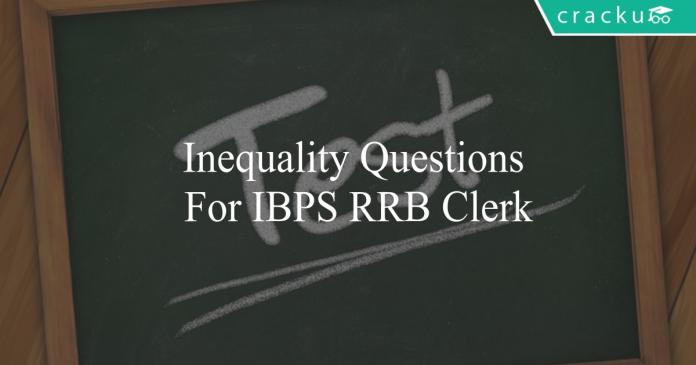Download Top-20 IBPS RRB Clerk Inequality Questions PDF. Inequality questions based on asked questions in previous year exam papers very important for the IBPS RRB Assistant exam
Download Inequality Questions For IBPS RRB Clerk
35 IBPS RRB Clerk Mocks @ Rs. 149
70 IBPS RRB (PO + Clerk) Mocks @ Rs. 199
Take a free mock test for IBPS RRB Clerk
Download IBPS RRB Clerk Previous Papers PDF
Instructions
In the following question, the relationship between different elements is given along with two conclusions. Find out the conclusion which definitely follows from the given relationship and choose the option accordingly.
Question 1: $ Z\geq Y\geq X=W ; W= P ; B>Z>A\geq C$
Conclusion I : $Z\geq P $
Conclusion II: $ A=Y $
a) Only conclusion I follows
b) Only conclusion II follows
c) Both the conclusions follow
d) Either conclusion I or conclusion II follows
e) None of the conclusions follows
Question 2: $X=Y=Z ; S>R\geq Z ; P>Q\geq R$
Conclusion I : $ P\geq Z$
Conclusion II: $ S>X $
a) Only conclusion I follows
b) Only conclusion II follows
c) Both the conclusions follow
d) Either conclusion I or conclusion II follows
e) None of the conclusions follows
Question 3: $A>B\geq C\geq D ; H = K = N ; G = C \geq F = H$
Conclusion I : $A>H$
Conclusion II: $B\geq N$
a) Only conclusion I follows
b) Only conclusion II follows
c) Both the conclusions follow
d) Either conclusion I or conclusion II follows
e) None of the conclusions follows
Instructions
In the following question, the relationship between different elements is given along with two conclusions. Find out the conclusion which definitely follows from the given relationship and choose the option accordingly.
Question 4: $P < A \leq N = I < C; J \geq O > Y; P \geq J;$
Conclusion I : $I \geq Y$
Conclusion II: $O \leq N$
a) Only conclusion I follows
b) Only conclusion II follows
c) Both the conclusions follow
d) Either conclusion I or conclusion II follows
e) None of the conclusions follows
Question 5: $T \leq A \leq L; E < N \leq D = Z \leq F < R; T \geq R;$
Conclusion I : $L > R$
Conclusion II: $E < T$
a) Only conclusion I follows
b) Only conclusion II follows
c) Both the conclusions follow
d) Either conclusion I or conclusion II follows
e) None of the conclusions follows
Question 6: $B \leq O < K \leq E < Y; V > R = C \geq D; V \leq B$
Conclusion I : $K > C$
Conclusion II: $D < E$
a) Only conclusion I follows
b) Only conclusion II follows
c) Both the conclusions follow
d) Either conclusion I or conclusion II follows
e) None of the conclusions follows
Instructions
In the following question, the relationship between different elements is given along with two conclusions. Find out the conclusion which definitely follows from the given relationship and choose the option accordingly.
Question 7: $R = E \geq M > O; B \leq I = T \leq S = H; R \leq B$
Conclusion I : $E \leq S$
Conclusion II: $H > M$
a) Only conclusion I follows
b) Only conclusion II follows
c) Both the conclusions follow
d) Either conclusion I or conclusion II follows
e) None of the conclusions follows
Question 8: $H \leq A \leq R = S < T; K \geq E > Y; K \leq H;$
Conclusion I : $S > E$
Conclusion II: $Y \leq R$
a) Only conclusion I follows
b) Only conclusion II follows
c) Both the conclusions follow
d) Either conclusion I or conclusion II follows
e) None of the conclusions follows
Question 9: $M \leq F \leq G; T < R \leq I = C \leq H < Y; T \geq G;$
Conclusion I : $M \leq H$
Conclusion II: $Y > G$
a) Only conclusion I follows
b) Only conclusion II follows
c) Both the conclusions follow
d) Either conclusion I or conclusion II follows
e) None of the conclusions follows
Question 10: $Q \leq U < A \leq N < T; D > I = L \geq R; T \leq R$
Conclusion I : $I \geq T$
Conclusion II: $Q < D$
a) Only conclusion I follows
b) Only conclusion II follows
c) Both the conclusions follow
d) Either conclusion I or conclusion II follows
e) None of the conclusions follows
Free Mock Test for IBPS RRB Clerk
IBPS RRB Clerk Previous Papers
Instructions
In the following question, the relationship between different elements is given along with two conclusions. Find out the conclusion which definitely follows from the given relationship and choose the option accordingly.
Question 11: $B \leq O = T \leq L = E; M > S \geq U > Q; E \leq Q$
Conclusion I : $M > O$
Conclusion II: $B < Q$
a) Only conclusion I follows
b) Only conclusion II follows
c) Both the conclusions follow
d) Either conclusion I or conclusion II follows
e) None of the conclusions follows
Question 12: $N \leq O \leq V = A; S \geq B > T; A \leq T;$
Conclusion I : $T > N$
Conclusion II: $O \leq S$
a) Only conclusion I follows
b) Only conclusion II follows
c) Both the conclusions follow
d) Either conclusion I or conclusion II follows
e) None of the conclusions follows
Question 13: $ W < A \leq T = C \leq H; L \leq E = G \leq O; W \geq O;$
Conclusion I : $W > L$
Conclusion II: $H > O$
a) Only conclusion I follows
b) Only conclusion II follows
c) Both the conclusions follow
d) Either conclusion I or conclusion II follows
e) None of the conclusions follows
Question 14: $P \leq G < H \leq R; J > E = S \geq I > C = A; R \leq A$
Conclusion I : $E > P$
Conclusion II: $J > H$
a) Only conclusion I follows
b) Only conclusion II follows
c) Both the conclusions follow
d) Either conclusion I or conclusion II follows
e) None of the conclusions follows
Instructions
In the following question, the relationship between different elements is given along with two conclusions. Find out the conclusion which definitely follows from the given relationship and choose the option accordingly.
Question 15: $D \leq O < N \leq A; H \geq B > S; A \leq S;$
Conclusion I : $H \geq D$
Conclusion II: $O \leq S$
a) Only conclusion I follows
b) Only conclusion II follows
c) Both the conclusions follow
d) Either conclusion I or conclusion II follows
e) None of the conclusions follows
Question 16: $L \leq O = C \leq T; K < E \leq Y; Y \leq L;$
Conclusion I : $T > Y$
Conclusion II: $O \geq E$
a) Only conclusion I follows
b) Only conclusion II follows
c) Both the conclusions follow
d) Either conclusion I or conclusion II follows
e) None of the conclusions follows
Question 17: $M \leq I < K \leq Y; H > A = R \geq V > E = Y; M \geq D$
Conclusion I : $I < R$
Conclusion II: $D \leq I$
a) Only conclusion I follows
b) Only conclusion II follows
c) Both the conclusions follow
d) Either conclusion I or conclusion II follows
e) None of the conclusions follows
Instructions
In the following question, the relationship between different elements is given along with two conclusions. Find out the conclusion which definitely follows from the given relationship and choose the option accordingly.
Question 18: $X < Y \leq Z< W; M > N \geq W; X > K$
Conclusion I : $N > X$
Conclusion II: $Y < M$
a) Only conclusion I follows
b) Only conclusion II follows
c) Both the conclusions follow
d) Either conclusion I or conclusion II follows
e) None of the conclusions follows
Question 19: $F \geq K > Z \geq P; W > V \geq D; P = W$
Conclusion I : $Z \geq D$
Conclusion II: $F\leq V$
a) Only conclusion I follows
b) Only conclusion II follows
c) Both the conclusions follow
d) Either conclusion I or conclusion II follows
e) None of the conclusions follows
Question 20: $E = F \geq T \geq R; Q > J = O; Q < Z < R$
Conclusion I : $Z < F$
Conclusion II: $T >O$
a) Only conclusion I follows
b) Only conclusion II follows
c) Both the conclusions follow
d) Either conclusion I or conclusion II follows
e) None of the conclusions follows
Quantitative Aptitude formulas PDF
520 Banking Mocks – Just Rs. 499
Answers & Solutions:
1) Answer (A)
$Z\geq Y\geq X=W= P$ i.e. $ Z\geq P $. Therefore, conclusion 1 follows.
No relation between A and Y can be established. Therefore, conclusion 2 does not follow
Hence, option A is the correct answer.
2) Answer (B)
$ P>Q\geq R\geq Z $ i.e. $ P> Z $. Hence, conclusion 1 does not follow
$ S>R\geq Z=X $ i.e. $ S>X $. Hence, conclusion 2 follows
Hence, option B is the correct answer.
3) Answer (C)
$A>B\geq C \geq F = H$. Hence, $ A>H $. Therefore, conclusion 1 follows.
$ B \geq C \geq F = H =K = N $ i.e. $B\geq N$.Therefore, conclusion 2 follows.
Hence, option C is the correct answer.
4) Answer (E)
From $J \geq O > Y$ and $P \geq J$; we can say that $P \geq J \geq O > Y$.
From $P \geq J \geq O > Y$ and $P < A \leq N = I < C$ we can say that $C > I = N \geq A > P \geq J \geq O > Y$.
In conclusion I, it should be $I > Y$, hence conclusion I is incorrect.
In conclusion II, it should be $O < N$, hence conclusion II is incorrect.
We can see that both the conclusions are false. Therefore, option E is the correct answer.
5) Answer (B)
From $T \leq A \leq L$; and $T \geq R$; we can say that $L \geq A \geq T \geq R$.
From $L \geq A \geq T \geq R$ and $E < N \leq D = Z \leq F < R$ we can say that $L \geq A \geq T \geq R > F \geq Z = D \geq N > E$
In conclusion I, it should be $L \geq R$, hence conclusion I is incorrect.
We can see that only conclusion II is true. Therefore, option B is the correct answer.
6) Answer (C)
From $V > R = C \geq D$; and $V \leq B$; we can say that $B \geq V > R = C \geq D$.
From $B \geq V > R = C \geq D$ and $B \leq O < K \leq E < Y$ we can say that $Y > E \geq K > O \geq B \geq V > R = C \geq D$.
We can see that both the conclusions are true. Therefore, option C is the correct answer.
7) Answer (A)
From $R = E \geq M > O$ and $R \leq B$ we can say that $B \geq R = E \geq M > O$.
From $B \geq R = E \geq M > O$ and $B \leq I = T \leq S = H$ we can say that $H = S \geq T = I \geq B \geq R = E \geq M > O$.
In conclusion II, it should be $H \geq M$, hence, conclusion II is incorrect.
We can see that the conclusion I is true. Therefore, option A is the correct answer.
8) Answer (E)
From $K \geq E > Y$ and $K \leq H$; we can say that $H \geq K \geq E > Y$.
From $H \geq K \geq E > Y$ and $H \leq A \leq R = S < T$ we can say that $T > S = R \geq A \geq H \geq K \geq E > Y$.
In conclusion I, it should be $S \geq E$, hence conclusion I is incorrect.
In conclusion II, it should be $Y < R$, hence conclusion II is incorrect.
We can see that both the conclusions are false. Therefore, option E is the correct answer.
9) Answer (B)
From $T < R \leq I = C \leq H < Y$; and $T \geq G$; we can say that $Y > H \geq C = I \geq R > T \geq G$.
From $Y > H \geq C = I \geq R > T \geq G$ and $M \leq F \leq G$ we can say that $Y > H \geq C = I \geq R > T \geq G \geq F \geq M$
In conclusion I, it should be $M < H$, hence conclusion I is incorrect.
We can see that only conclusion II is true. Therefore, option B is the correct answer.
10) Answer (C)
From $D > I = L \geq R$; and $T \leq R$; we can say that $D > I = L \geq R \geq T$.
From $D > I = L \geq R \geq T$ and $Q \leq U < A \leq N < T$ we can say that $D > I = L \geq R \geq T > N \geq A > U \geq Q$.
We can see that both the conclusions are true. Therefore, option C is the correct answer.
11) Answer (A)
From $E \leq Q$ and $M > S \geq U > Q$; we can say that $M > S \geq U > Q \geq E$.
From $M > S \geq U > Q \geq E$ and $B \leq O = T \leq L = E$ we can say that $M > S \geq U > Q \geq E = L \geq T = O \geq B$.
In conclusion II, it should be $B \leq Q$ hence, conclusion II is incorrect.
We can see that the conclusion I is true. Therefore, option A is the correct answer.
12) Answer (E)
From $S \geq B > T$ and $A \leq T$; we can say that $S \geq B > T \geq A$.
From $S \geq B > T \geq A$ and $N \leq O \leq V = A$ we can say that $S \geq B > T \geq A = V \geq O \geq N$.
In conclusion I, it should be $T \geq N$, hence conclusion I is incorrect.
In conclusion II, it should be $O < S$, hence conclusion II is incorrect.
We can see that both the conclusions are false. Therefore, option E is the correct answer.
13) Answer (B)
From $W < A \leq T = C \leq H$; and $W \geq O$; we can say that $H \geq C = T \geq A > W \geq O$.
From $H \geq C = T \geq A > W \geq O$ and $L \leq E = G \leq O$ we can say that $H \geq C = T \geq A > W \geq O \geq G = E \geq L$.
In conclusion I, it should be $W \geq L$, hence conclusion I is incorrect.
We can see that only conclusion II is true. Therefore, option B is the correct answer.
14) Answer (C)
From $J > E = S \geq I > C = A$; and $R \leq A$; we can say that $J > E = S \geq I > C = A \geq R$.
From $J > E = S \geq I > C = A \geq R$ and $P \leq G < H \leq R$ we can say that $J > E = S \geq I > C = A \geq R \geq H > G \geq P$.
We can see that both the conclusions are true. Therefore, option C is the correct answer.
15) Answer (E)
From $H \geq B > S$ and $A \leq S$; we can say that $H \geq B > S \geq A$.
From $H \geq B > S \geq A$ and $D \leq O < N \leq A$ we can say that $H \geq B > S \geq A \geq N > O \geq D$.
In conclusion I, it should be $H > D$, hence conclusion I is incorrect.
In conclusion II, it should be $O < S$, hence conclusion II is incorrect.
We can see that both the conclusions are false. Therefore, option E is the correct answer.
16) Answer (B)
From $K < E \leq Y$; and $Y \leq L$; we can say that $L \geq Y \geq E > K$.
From $L \geq Y \geq E > K$ and $L \leq O = C \leq T$ we can say that $T \geq C = O \geq L \geq Y \geq E > K$.
In conclusion I, it should be $T \geq Y$, hence conclusion I is incorrect.
We can see that only conclusion II is true. Therefore, option B is the correct answer.
17) Answer (C)
From $M \leq I < K \leq Y$; and $H > A = R \geq V > E = Y$; we can say that $H > A = R \geq V > E = Y \geq K > I \geq M$.
From $H > A = R \geq V > E = Y \geq K > I \geq M$ and $M \geq D$ we can say that $H > A = R \geq V > E = Y \geq K > I \geq M \geq D$.
We can see that both the conclusions are true. Therefore, option C is the correct answer.
18) Answer (C)
$N\geq W>Z\geq Y>X$. Thus, $N>X$. Hence, conclusion 1 follows.
$M>N\geq W>Z\geq Y$. Thus, $M>Y$. Hence, conclusion 2 follows.
Thus, both the conclusions follows.
Hence, option C is the correct answer.
19) Answer (E)
$Z\geq P=W>V\geq D$. Thus, $Z>D$. Hence, conclusion 1 does not follow
$F\geq K > Z\geq P=W>V$. Thus, $F>V$. Hence, conclusion 2 does not follow.
Thus, none of the conclusion follows.
Hence, option E is the correct answer.
20) Answer (C)
$ F\geq T\geq R>Z $. Thus, $ Z>F $. Hence, conclusion 1 follows.
$ T\geq R>Z>Q>J=O$. Thus, $T>O$. Hence, conclusion 2 follows.
Thus, both the conclusion follows.
Hence, option C is the correct answer.





